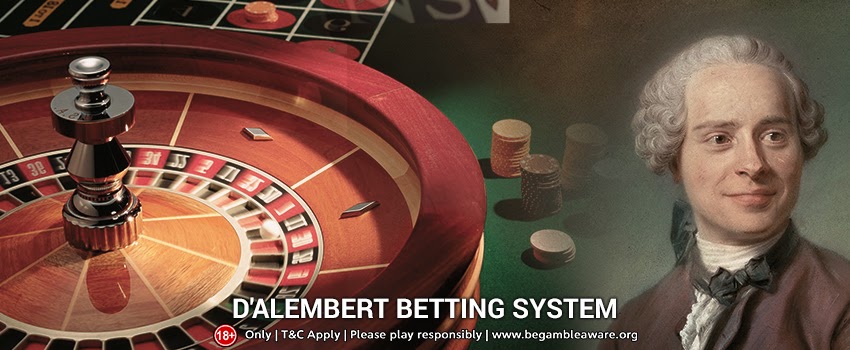
Though it shares some similar features with Martingale, both are completely different in other terms. Both are negative progressions which involve increasing bets after losing a bet and reducing the bet amount after winning.However, with the D’Alembert betting in the Roulette system, stakes are raised more slowly than with the Martingale, making it less possible for stakes to get ridiculously high. To some extent, this is an advantage, but the flipside to this is that damages are slowly recovered. So the odds of making any kind of loss are actually higher, but when hitting a string of bad luck, the scale of any losses is usually less devastating.
Let’s first start with how the D’Alembert Roulette system came into existence.
What is the D’Alembert Roulette System?
The D’Alembert method is named after a French mathematician who lived in the 18th century, Jean-Baptiste le Rond d’Alembert. Though d’Alembert was known for his breakthroughs in physics, less well-proven were his assumptions regarding equilibrium in numbers.
The D’Alembert system, like the Martingale system, is based on bets made on the table’s even-money areas (Red/Black, Odd/Even, 1-18/19-36, etc.). Instead of doubling the stake after a losing bet, as in Martingale, one unit is added to the stake of the player. The stake declines by one unit after a victory.
In a nearly equal number of reds that appear as blacks, odds and evens, and so on, the system places a lot of trust. But with the added edge of the wall, the odds are still in favour of the house.
Advantages of the D’Alembert Roulette System
D’Alembert’s greatest advantage is that it holds a grip on the streaks, at least in the short run. On each losing bet, as in the Martingale, you’re not doubling the bets, and things do balance out if you win as many spins as you lose.
For e.g., a run of winning spins from games 11-15 will leave you in benefit in our above example – only. And your losses are just 21x your base stake, after six losing spins in a row. With Martingale, the same losing run will leave you £ 63 in the red.
Although D’Alembert himself was fond of the idea of balance, streaks were also known by him. Players can go on long hot streaks and bad cold ones in roulette, as in any casino games.
Disadvantages of D’Alembert Roulette System
From time to time, losing streaks happen to all gamblers. The D’Alembert isn’t immune to this, and if you have any bad luck, even raising the stakes by one unit will result in significant losses.
But in roulette, cold streaks can go on for a long time, and one has to take into account the edge of the building. Roulette gives the house an intrinsic advantage since all even-money bets would be lost by the green zero (0 – or double zero in American Roulette).
Over time, the casino would statistically lose cash to roulette players. It is 2.7 per cent for European Roulette system or £ 2.70 for every £ 100 wagered. That’s 5.26% for American Roulette – £ 5.26 on average for every £ 100 bet.
One way to get the streaks round is to slightly raise the law of the base unit. For instance, you can lift it by 2 or 3 instead of increasing the unit by one on every losing spin.
How to use D’Alembert Betting in the Roulette System?
When making even cash bets at the roulette table, the D’Alembert method is usually applied, but it can be used for almost any money wager. It’s based on the principle that even money bets can have some equilibrium. The rule is that you can always win approximately the same amount of money bets as you lose. To put it another way, it works on the premise that during a roulette session, red would show up about the same amount of times as black.
It is a very simple method to understand, which perhaps explains to some degree, its success. To put it into effect, here’s a short reference.
Rule 1-Decide your unit of foundation
You must specify what the base stacking unit is going to be before you start. This can be whatever you want, but we would suggest that you make it no more than 5% of your overall bankroll. In our view, 2% is the best.
Rule 2-Start with one unit
On the first bet of any cycle when using the D’Alembert method, you must take exactly one base stacking unit.
Rule 3-Raising stakes after a loss
After any losing bet, one base stacking unit must raise the stake for the following wager. For instance, if you started with $5, then you would raise the stake to $10 if you lost. If you were to lose again, you would lift the stake to $15.
Rule 4: Minimize Stakes After a Win
The stake for the following wager could decrease by one base stake unit after each winning wager. If a wager is won for a stake of just one unit, then the subsequent wager remains the same.
This method is, as you can see, definitely easy enough to incorporate. And, if you win about the same amount of bets as you lose, you can come out ahead. This is because there would be higher stakes for your winning bets than for your losing bets.
Conclusion
The D’Alembert Roulette system sounds great on paper. But its practical application in real life can be quite tricky. It is less risky than the Martingale system. This is because you increase your bets slowly, so you are actually not in the high-risk zone anytime in the game.